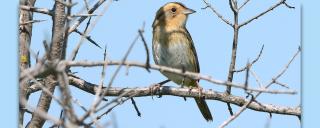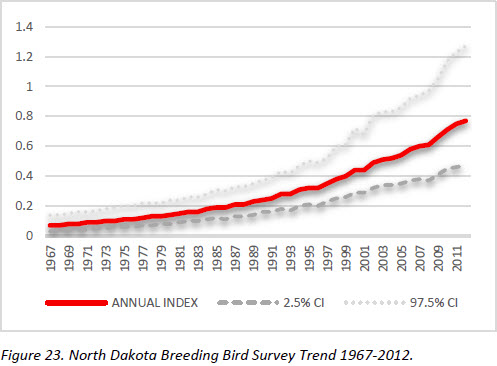
Nelson's Sharp-tailed Sparrow
| Scientific Name | Ammodramus nelsoni |
|---|---|
| General Description | L 5”, WS 7”, 0.6 oz. Yellow face and throat, finely streaked breast, gray nape and crown, and pronounced white belly. |
| Status | Occurs in North Dakota from mid-May to mid-September. Peak breeding season mid-June to early August. |
| Abundance | Uncommon. |
| Primary Habitat | Fens, shallow-marsh and wet meadow zones of wetlands. |
| Federal Status | Migratory Bird. |
| Reason for Designation | This sparrow has a restricted breeding range limited to North Dakota, parts of Minnesota, South Dakota, and central Canada. It included on the National USFWS Birds of Conservation Concern list, and also in Region 6 and BCR 11. Partners in Flight (PIF) identifies the Nelson’s Sparrow as a Regional Stewardship Species and U.S.-Canada Stewardship Species. |
Locations and Conditions of Key Habitat
Preferred Habitat
Nelson’s Sparrows in North Dakota use freshwater wetlands with dense, emergent vegetation or damp areas with dense grass. Also use fens, wet meadows, lake margins, emergent cattails, native prairie, idle fields, CRP and DNC. Cordgrass, squirreltail, whitetop, and phragmites are usually the most commonly associated plants. Nest on the ground or slightly above in shallow-marsh and deepmarsh zones of wetlands in dry years and the wet-meadow zone of wetlands in wet years. A rather deep, persistent litter level is preferred. Forage on the ground for insects and seeds.
Key Areas and Conditions for Nelson's Sparrow in North Dakota
No specific sites have been identified.
Problems Which May Affect this Species
Habitat
Destruction and/or degradation of grasslands and wet meadows. Presence of sharp-tailed sparrows may be affected by the yearly moisture conditions. Annual grazing, mowing, and haying may negatively affect their presence, but periodic maintenance of grassland is needed to stimulate grass growth or prevent woody encroachment.
Other Natural or Manmade Factors
Recently a relatively high level of mercury level has been detected in Nelson’s Sparrows in North Dakota. Some mortality from collisions with communication towers.
Research and Survey Efforts
Current Research or Surveys
- Currently nothing specific to the species in North Dakota.
Previous Research or Surveys
- Little effort has been applied to research or surveys specifically for Nelson’s sharp-tailed sparrow in North Dakota. Several studies which include sharp-tailed sparrow and other grassland associated species have taken place in North Dakota. Examples include the benefits of CRP to grassland nesting passerines and the effects of various management practices.
- Fair number of published reports and gray literature on this species throughout its range.
Additional Research or Surveys Needed
- Little is known on area requirements and other basic habitat needs.
- Determine efficacy of BBS for detecting Nelson’s Sparrows and potential factors for increasing trend in North Dakota.
Population and Trend Estimates

- PIF Global Population Estimate: 1,100,000
- PIF North American Population Estimate: 1,100,000
- PIF North Dakota Population Estimate: 150,000
- North Dakota BBS Trend: see figure 23
- Survey-wide BBS Trend 1966-2012: 1.60
Management Recommendations
- Removal of vegetation by burning or mowing may cause negative effects.
- Increase ground cover in areas where short grasses prevail.
- Construction of communication towers should follow the guidance of “Service Interim Guidelines for Recommendations on Communications Tower Siting, Construction, Operation, and Decommissioning” and American Bird Conservancy Collision Program framework.
Monitoring Plans
According to the Partners in Flight Landbird Conservation Plan, long-term population trend monitoring such as the Breeding Bird Survey generally produces imprecise trends at the continental scale. Ensuring all BBS routes are conducted annually is priority. Future monitoring proposals should follow recommendations North American Bird Conservation Initiative ‘Opportunities for Improving Avian Monitoring’.
2005-2015 Progress
The Nelson’s Sparrow remains a Level I Species of Conservation Priority. Several State Wildlife Grant Projects (T2- 9-R, T2-11-HM, T-18-R, T-21-D, T-22-HM, T-23-HM, T-25-HM, T-27-HM, T-37-D) have contributed to habitat enhancement of wetlands and grasslands for Nelson’s Sparrow and other wetland/grassland dependent birds.

Note: A listing of works consulted when compiling the information on this page may be found in the 2015 State Wildlife Action Plan.
